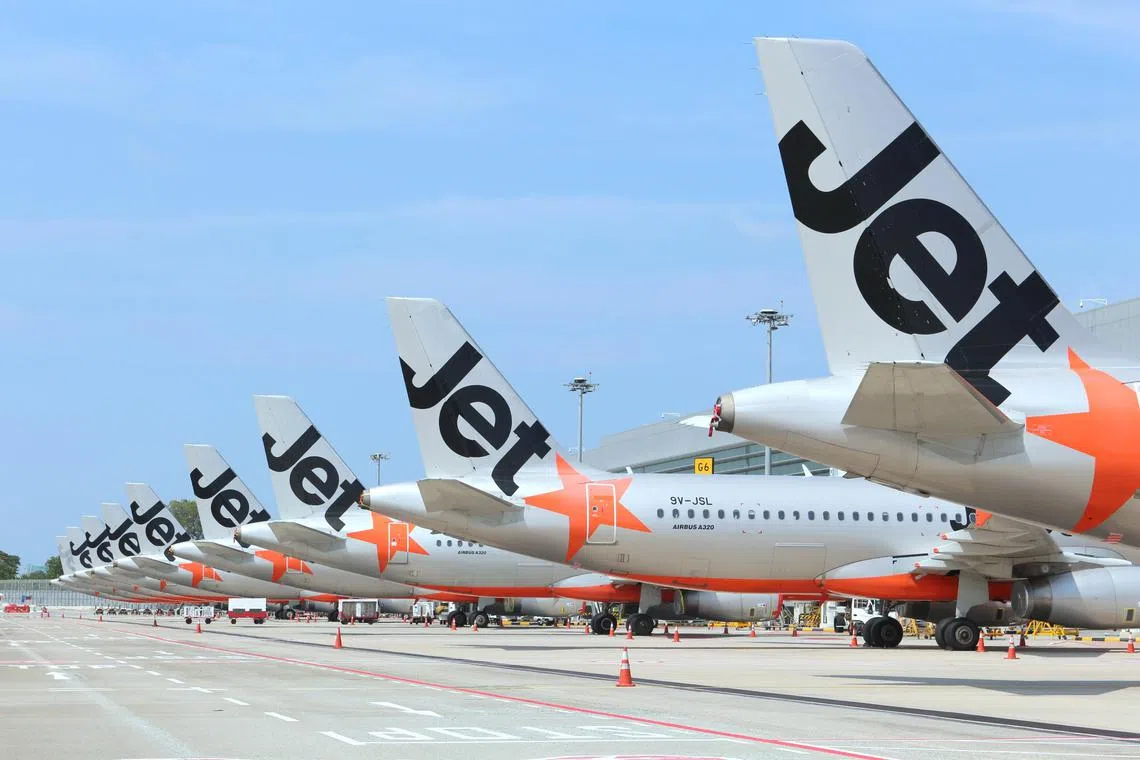Jetstar Asia to hire more than 200 pilots, cabin crew as budget airline rebuilds capacity
Sign up now: Get ST's newsletters delivered to your inbox

Two more aircraft will be added to Jetstar Asia's fleet of seven planes by the end of 2023.
PHOTO: JETSTAR ASIA
Follow topic:
SINGAPORE – Low-cost carrier Jetstar Asia plans to hire more than 200 pilots and cabin crew as part of efforts to rebuild capacity post-Covid-19.
Two more Airbus A320 aircraft will join its fleet of seven by the end of 2023.
Announcing these plans in a LinkedIn post on Tuesday, Jetstar Asia chief executive Barathan Pasupathi said plans are also afoot to add more planes to the airline’s stable in the next year and a half. He did not give details.
“We are embarking on an exciting chapter of sustainable growth,” Mr Pasupathi said.
The Singapore-based airline, he added, intends to rehire a number of pilots who left at the peak of the pandemic.
Jetstar Asia, jointly owned by Singapore investment company Westbrook Investments and Australian flag carrier Qantas, will also induct new cadet pilots and cabin crew interns. In addition, it will hire graduates from aviation academies through a direct-entry recruitment programme.
A Jetstar Asia spokesman said it already has the crew needed for the two A320s that will be added to its fleet in 2023. “We are now commencing a recruitment programme for roles required over the next 12 months and seeing strong interest,” she said.
In July 2020, when borders were shut and air travel demand nosedived because of the Covid-19 pandemic, Jetstar Asia cut about 180 jobs
Between 2020 and 2022, the carrier shed 11 A320s, reducing its fleet size from 18 to seven.
Since then, international air travel in Asia-Pacific has been recovering steadily.
Passenger traffic at Changi Airport, for instance, crossed the five-million mark for the first time in June 2023 since the start of the pandemic
Even so, Jetstar Asia has been slower to rebuild capacity than its closest rivals Scoot and AirAsia Group.
Based on data from OAG, a database of airline schedules, Jetstar Asia’s seat capacity in Singapore is at 42 per cent of 2019 levels, compared with 113 per cent for Scoot and 105 per cent for AirAsia Group.
The Jetstar Group was mired in months of negotiations with Changi Airport Group (CAG) over the relocation of its operations from Terminal 1 to Terminal 4
Jetstar Asia has since started to resume more of its services. In April, it restarted flights to China after a three-year stoppage due to the pandemic, with services to Haikou on the island province of Hainan.
In July, it announced plans to resume direct flights between Singapore and Okinawa in November. In November, it will also start flying between Singapore and Osaka via Manila.
The airline expects to fly more than 180,000 passengers between Singapore and Japan on the two routes yearly, it said earlier.
In its reply to ST, Jetstar Asia’s spokesman said its relocation to Terminal 4 has created room to enlarge its capacity and network from Changi Airport. “We are seeing high demand for our flights to Haikou and are excited to see China resume visa-free travel for Singaporeans,” she said.
Independent analyst Brendan Sobie said Jetstar Asia’s plans are not about growth, but about establishing a meaningful presence.
In a LinkedIn post on Tuesday, Mr Sobie of Sobie Aviation noted that Qantas had disclosed at its annual investor day in May that Jetstar Asia would add another four aircraft soon after the initial two. This will result in an eventual fleet size of 13 planes.
He also pointed out that Changi Airport has reinstated its 80-20 slot-use rule, which requires airlines to use their allocated take-off and landing slots at least 80 per cent of the time, though there are still exemptions for many North Asian routes.
Mr Sobie said only about 13 per cent of Jetstar Asia’s slots at Changi are for North Asia.
He added: “It is strategically critical for Jetstar Asia to quickly rebuild its fleet to avoid losing slots at Changi (Airport)... and many of its destination airports.”
CAG said international principles guide the issuance of slots at the airport, and airlines are required to return slots that will not be used to ensure that airport resources are not wasted.
“However, given the different pace of aviation recovery as well as local challenges, some countries and their airlines have sought exemption from the 80-20 rule, including those in North Asia,” said a CAG spokesman.


